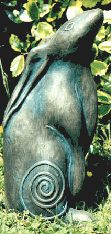
The following is excepted from the website of the University of British Columbia (UBC) Botanical Garden.
___________________________________
The “Minotaur with Hare” by UK artist Sophie Ryder is on display at UBC Botanical Garden for 18 months as part of the Vancouver Sculpture Biennale: Open Spaces 2005/2006. Weighing 800kg and measuring 2.7m (7') tall, the minotaur will overlook a soon-to-be-constructed traditional turf maze, representing the Greek myth of Theseus and the Minotaur.
The story of the Minotaur as told by the classical authors is one of heroism and tragedy. The wife of King Minos of Crete, Pasiphae, was cursed by the god Poseidon with zoophilia, causing her to mate with a bull. Of this union came forth the ghastly Minotaur. The legendary craftsman Daedalus built a labyrinth to house the Minotaur and King Minos exacted a periodic tribute of seven virgins and seven young men from nearby Athens to be given to the Minotaur.
Theseus, son of the King of Athens, resolved to end this practice by offering himself as part of the tribute. Ariadne, the daughter of Minos, fell in love with Theseus and gave him a magic sword to kill the Minotaur and a thread to help him find his way out of the labyrinth. The deed done, Theseus and Ariadne fled Crete together, although Theseus shortly after callously abandoned Ariadne on the island of Naxos.
There was a final tragic act to this tale. Theseus’ father had asked him to change his black sails for white if he remained alive so his safe return could be witnessed from afar. Distracted by the hullabaloo in Crete, Theseus forgot his promise. Thinking his son dead, his father threw himself to his death over the cliffs of Cape Sounion.
In this artwork by Sophie Ryder, the story of the Minotaur is given a non-classical twist as the Minotaur is shown holding a hare, a symbol of swiftness and vulnerability, to contrast with the menacing bulk of the Minotaur itself.



















